

Everything Open and Free. Coworking. Coworking is a style of work that involves a shared working environment, often an office, and independent activity.
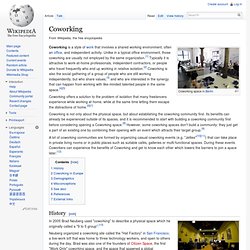
Unlike in a typical office environment, those coworking are usually not employed by the same organization.[1] Typically it is attractive to work-at-home professionals, independent contractors, or people who travel frequently who end up working in relative isolation.[2] Coworking is also the social gathering of a group of people who are still working independently, but who share values,[3] and who are interested in the synergy that can happen from working with like-minded talented people in the same space.[4][5] Coworking offers a solution to the problem of isolation that many freelancers experience while working at home, while at the same time letting them escape the distractions of home.[6][7] Coworking is not only about the physical space, but about establishing the coworking community first.
History[edit] Social peer-to-peer processes. Peer learning. One of the most visible approaches to peer learning comes out of cognitive psychology, and is applied within a "mainstream" educational framework: "Peer learning is an educational practice in which students interact with other students to attain educational goals.
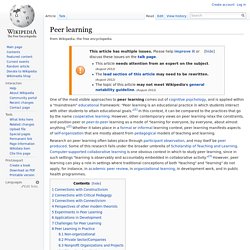
"[1] In this context, it can be compared to the practices that go by the name cooperative learning. However, other contemporary views on peer learning relax the constraints, and position peer or peer-to-peer learning as a mode of "learning for everyone, by everyone, about almost anything. "[2] Whether it takes place in a formal or informal learning context, peer learning manifests aspects of self-organization that are mostly absent from pedagogical models of teaching and learning. Research on peer learning often takes place through participant observation, and may itself be peer produced. Connections with Constructivism[edit] The three distinguishing features of constructivist theory are claims that:[5] Guilmette cites Anne K. Georgism. Georgist ideas were popular and influential in the earlier part of the 20th century.[13] Political parties, institutions and communities were founded based on Georgist principles during that time.
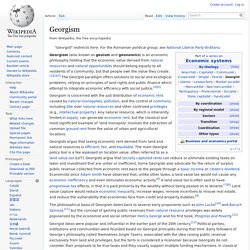
Early followers of George's philosophy called themselves Single Taxers, associated with the idea raising public revenue exclusively from land and privileges, but the term is considered a misnomer because Georgists do not consider their proposals to be true taxes and they usually support multiple funding mechanisms. In classical and Georgist economics, the term 'land' is defined as all locations, natural opportunities, resources, physical forces, and government privileges over economic domains, which is closely related to the concept of commons.[14] Georgism was coined later, and some prefer the term geoism or geonomics to distinguish their beliefs from those of Henry George.[15] instead.[16] Main tenets[edit] In Progress and Poverty George argued: "We must make land common property.
Richard T. Free software licence. A free software licence is a notice that grants the recipient of a piece of software extensive rights to modify and redistribute that software.
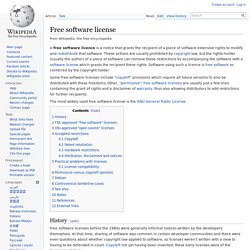
These actions are usually prohibited by copyright law, but the rights-holder (usually the author) of a piece of software can remove these restrictions by accompanying the software with a software license which grants the recipient these rights. Software using such a licence is free software as conferred by the copyright holder. Some free software licenses include "copyleft" provisions which require all future versions to also be distributed with these freedoms. Creative Commons. Creative Commons (CC) is a non-profit organization devoted to expanding the range of creative works available for others to build upon legally and to share.[1] The organization has released several copyright-licenses known as Creative Commons licenses free of charge to the public.

These licenses allow creators to communicate which rights they reserve, and which rights they waive for the benefit of recipients or other creators. An easy-to-understand one-page explanation of rights, with associated visual symbols, explains the specifics of each Creative Commons license. Creative Commons licenses do not replace copyright, but are based upon it. They replace individual negotiations for specific rights between copyright owner (licensor) and licensee, which are necessary under an "all rights reserved" copyright management, with a "some rights reserved" management employing standardized licenses for re-use cases where no commercial compensation is sought by the copyright owner.
Copyleft. Copyleft symbol Copyleft (a play on the word copyright) is the practice of using copyright law to offer the right to distribute copies and modified versions of a work and requiring that the same rights be preserved in modified versions of the work.
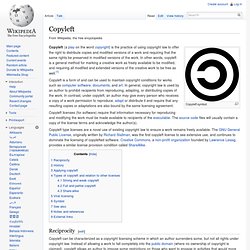
Open patent. The open patent movement seeks to build a portfolio of patented inventions that can freely be distributed under a copyleft-like license.[1] These works could be used as is, or improved, in which case the patent improvement would have to be re-licensed to the institution that holds the original patent, and from which the original work was licensed.
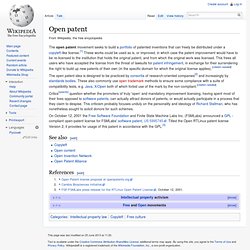
This frees all users who have accepted the license from the threat of lawsuits for patent infringement, in exchange for their surrendering the right to build up new patents of their own (in the specific domain for which the original license applies). [citation needed] Critics[specify] question whether the promoters of truly 'open' and mandatory improvement licensing, having spent most of their lives opposed to software patents, can actually attract donors of patents, or would actually participate in a process that they claim to despise.
On October 12, 2001 the Free Software Foundation and Finite State Machine Labs Inc. See also[edit] Public domain. Works in the public domain are those whose intellectual property rights have expired,[1] have been forfeited,[2] or are inapplicable.

Transparency (social) Transparency is a general quality.
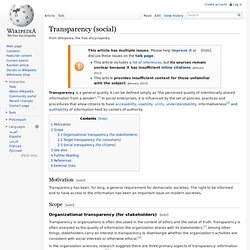
It can be defined simply as "the perceived quality of intentionally shared information from a sender".[1] In social enterprises, it is influenced by the set of policies, practices and procedures that allow citizens to have accessibility, usability, utility, understandability, informativeness[2] and auditability of information held by centers of authority.
Transparency has been, for long, a general requirement for democratic societies. The right to be informed and to have access to the information has been an important issue on modern societies. Crowdsourcing. Crowdsourcing is a sourcing model in which individuals or organizations obtain goods and services.
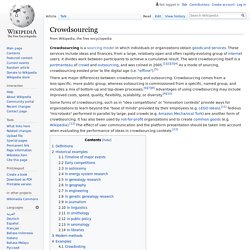
These services include ideas and finances, from a large, relatively open and often rapidly-evolving group of internet users; it divides work between participants to achieve a cumulative result. The word crowdsourcing itself is a portmanteau of crowd and outsourcing, and was coined in 2005.[1][2][3][4] As a mode of sourcing, crowdsourcing existed prior to the digital age (i.e. "offline").[5] There are major differences between crowdsourcing and outsourcing.
Co-creation. Co-creation is a form of marketing strategy or business strategy that emphasizes the generation and ongoing realization of mutual firm-customer value. It views markets as forums for firms and active customers to share, combine and renew each other's resources and capabilities to create value through new forms of interaction, service and learning mechanisms.
It differs from the traditional active firm – passive consumer market construct of the past. Co-created value arises in the form of personalised, unique experiences for the customer (value-in-use) and ongoing revenue, learning and enhanced market performance drivers for the firm (loyalty, relationships, customer word of mouth). Scholars C.K. Open source. Commons. Shared resources The commons is the cultural and natural resources accessible to all members of a society, including natural materials such as air, water, and a habitable earth. These resources are held in common, not owned privately. Commons can also be understood as natural resources that groups of people (communities, user groups) manage for individual and collective benefit. Open knowledge. Open content. The logo on the screen in the subject's left hand is a Creative Commons license, while the paper in his right hand explains that the image is open content.
History[edit] Originally, the Open content concept was invented by Michael Stutz, who in 1994 wrote the paper "Applying Copyleft to Non-Software Information" for the GNU Project. The "Open Content" term was later evangelized via the Open Content Project by David A. Wiley in 1998, and described works licensed under the Open Content License (a non-free share-alike license, see 'Free content' below) and other works licensed under similar terms.[2] It has since come to describe a broader class of content without conventional copyright restrictions. Open access (disambiguation) Open access may refer to: Open access, in publishing, free access to materialOpen access journal, a journal that gives open access to its articles Computing, communications and networking. Open data.